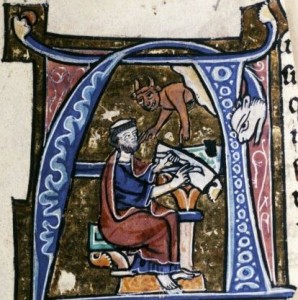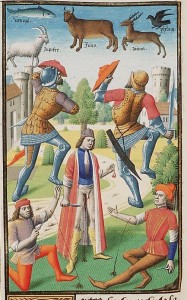
The thing about taking an unannounced eight-month break from blogging is that over the hiatus you build up quite the backlog of reader questions in your inbox. Weird, right? Of course, ninety percent of it comes from people who still want to argue over my “Ground Zero Mosque” post of nearly a year ago, but what better way to break multi-month hiatuses than by answering those few non-Gingrichy questions in a post? So consider this the first installment of the Got Medieval Reader Mailbag.
A curious reader writes,
I found this picture in The Arma website, devoted to ‘Renaissance Martial Arts’ (even though this page seems to be mainly medieval).
If you scroll down the page to where it’s written: “This strangely disturbing image has a sword and buckler man” & etc., etc.
The photo above this is of a man who seems to have castrated himself, as he is bleeding from his crotch and holding a pair of testicles. At his sides are 2 men who have pierced a vein in their arms and are spouting blood on the ground. What the soldiers in the background are doing, I have no idea.
[…]
I’ve looked everywhere for information on this, to no avail. I’m dying of curiosity as to what this is about, so if you can tell me anything about this, I would be ever so grateful.Thanks,
Lucille Lastnamewithheld
And so we have once again confirmation that I am widely regarded as the internet’s foremost expert on all things related to funky medieval genitalia. ((Pay attention, medievalist search committees. Surely your university lacks this particular specialty.)) I hope you didn’t die of curiosity waiting on me to respond, Lucille. And hoping also that the folks at the Arma website won’t mind, here’s the picture in question for the rest of you:

While I’m not familiar with that particular manuscript, I can be pretty confident in saying that the figure in the middle holding up his own castrated bits is the early 3rd-century Alexandrian church father Origen, because you see pictures of Origen standing in front of a constellation map holding up his own castrated bits a fair amount in medieval manuscript art. Depending on who you read, Origen castrated himself either so that he could tutor young women without suspicion or temptation or because he took Matthew 19:12 super-literally. Regardless of the reason he might have done it, if you see a dude holding his own castrated scrotum in his hands in a medieval manuscript, ninety-nine times out of a hundred the dude is Origen. ((If it looks like a dog biting off it’s own tackle, then it’s a beaver. But that’s a story for another time.))
As for what the guys behind him are doing, my vote is the Safety Dance.
Another curious reader writes,
Hi Folks
I just read an article of yours, reprinted on a history link by Robert Wilde. One of your comments in the Starbucks article refers to the fact? that Constantine did not leave Rome to the Roman Catholic popes.
Please comment on the words in Papal Rights and Privileges Pp 13-14 where the say THEMSELVES “When the Roman EMPIRE…..and peace of the “church” GUARANTEED, The emperor left Rome to the POPES….”
If you have information to the contrary, please quote page number, and works—otherwise , please set the record straight thanks.Robin Lastnamewithheld
Alas, the Starbucks piece. I was certain my investigative sleuthing would lead to front page news stories across the country and a guest spot on Hannity, but as of yet no one seems much to have cared that Starbucks is straight up lying about where their mermaid came from. The irony, of course, is that the mermaid they chose for their invented origin story, Melusine, taken from a fifteenth-century translation of the Roman de Melusine, is herself part of an invented origin story from the Middle Ages. Because, let’s face it, the temptation to fudge facts to make them more impressive is overpowering when you’re talking about your own origin. It’s highly unlikely that the guys who founded Starbucks drew inspiration from a 16th-century Norse woodcut, because there’s no such thing as a 16th-century Norse woodcut, just as it’s highly unlikely that the House of Lusignan descended from a twin-tailed mermaid named Melusine, because there’s no such thing as a twin-tailed mermaid.
And so as hard as it is for some to admit, it’s highly unlikely that the church in Rome was granted temporal authority over all the Roman Empire by Constantine. But it’s certainly very likely that when asked to give an account of why they wielded so much power and as an argument for still more power, Roman Catholics would invent a story and the documentation needed to back it up. Medieval popes and canon lawyers certainly wanted people to believe that the Church had absolute temporal power, and they pinned the claim to an imperial decree called the Donatio Constantini or “The Donation of Constantine.” But that decree turned out to be a forged document that had been inserted into a different collection of forged documents, the Pseudo-Isadorian Decretals. A double forgery! ((And two wrongs don’t make a right in this case.)) While many medieval monarchs had come up with reasons to ignore the Donatio, Lorenzo Valla, the famous Renaissance humanist, put the question of the document’s authenticity to bed by 1440. It’s a bit of a dull read, so you’ll be excused for not having looked it over, but ultimately we don’t need to, really, because the text of the Donation itself claims that Constantine gave all of Rome to Sylvester because the pope had cured him of his leprosy, and we’re all pretty sure now that whatever else they can do, popes can’t actually cure leprosy.
Now, Papal Rights and Privileges also turns out to be an interesting case. It’s a book written in 1889 by Francis P.C. Hays, a popular historian who’s really just uncritically trotting out the old Catholic line. But whyever would anyone ever cite a book from so long ago as an authority on anything? Turns out that it’s a fossilized reference only famous at all today because it somehow got into the Christian apocalypse lore that’s floating around, as part of a gloss explaining the meaning of Revelations Chapter 13.
A more industrious soul than I really ought to start collecting and studying these critical fossils. Wikipedia has certainly given renewed credence to a whole lot of out-of-date scholarly thinking, because out-of-date thinking often has the advantage of being in the public domain, and thus being easily reproducible and linkable for web purposes. There really is no better argument against the industrialized world’s continued extension and re-extension of copyrights and the academic tendency to bury everything behind paywalls: it’s dooming us to a world in which the only facts easily marshaled by the masses ((Or, at least, marshaled without fear of cease-and-desist reprisal.)) are those that years and years of critical work has already supplanted, a world where the cutting edge is perpetually the same old rusty edge from 1920-something. ((Turning the world into one of those islands in Rudolph’s Shiny New Year. I’ll admit, 1776 seemed like a pretty cool place, though. Every day the 4th of July!))
And that’s all the space we have for the Got Medieval Reader Mailbag this week. ((If the Starbucks post has taught me anything, readers’ interest is inversely proportional to the number of scroll bar clicks in a post.)) Do you have a question you’d like answered by Got Medieval? Did you submit a question in the last eight months that still burns like a fire in your brain? Use the contact form at the top of the page, send it on, and I’ll see what I can do–no promises, of course. Dangerous things, promises–they leave people expecting that a blog will be regularly maintained.